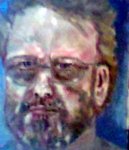Urban sprawl has been around for ever. Reading recent contributions on measuring this phenomenon [e.g. Elena G. Irwin, Nancy E. Bockstael and Hyun Jin Cho, "Measuring and modeling urban sprawl: Data, scale and spatial dependencies" or Charles Jaret, Ravi Ghadge, Lesley Williams Reid and Robert M. Adelman, "The Measurement of Suburban Sprawl: An Evaluation".] I became interested in urban porosity. While sprawl is primarily a phenomenon of the urban edge, to describe it and to explain it, there is a need to understand the dynamics of cities as 3D physical objects.
 As a preliminary step, there is a need for rules that will enable us to observe cities and to describe the extent and nature of porosity. I have been reading S.T. Hyde, S. Andersson, K. Larsson, Z. Blum, T. Landh, S. Lidin and B.W. Ninham, The Language of Shape, Elsevier, (1997) and Michael Burt's PERIODIC SPONGE SURFACES AND UNIFORM SPONGE POLYHEDRA IN NATURE AND IN THE REALM OF THE THEORETICALLY IMAGINABLE. I must admit that it is unclear to me where to go next. Any ideas?
As a preliminary step, there is a need for rules that will enable us to observe cities and to describe the extent and nature of porosity. I have been reading S.T. Hyde, S. Andersson, K. Larsson, Z. Blum, T. Landh, S. Lidin and B.W. Ninham, The Language of Shape, Elsevier, (1997) and Michael Burt's PERIODIC SPONGE SURFACES AND UNIFORM SPONGE POLYHEDRA IN NATURE AND IN THE REALM OF THE THEORETICALLY IMAGINABLE. I must admit that it is unclear to me where to go next. Any ideas? At the same time, we are making a bit of progress in formulating the structural relationships that should be at the heart of the relevant modeling effort. See Czamanski, D., Roth, R., “Characteristic time, developers’ behavior and leapfrogging dynamics of high-rise buildings" forthcoming in Annals of Regional Science, 2009.


No comments:
Post a Comment